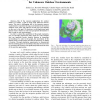Free Online Productivity Tools
i2Speak
i2Symbol
i2OCR
iTex2Img
iWeb2Print
iWeb2Shot
i2Type
iPdf2Split
iPdf2Merge
i2Bopomofo
i2Arabic
i2Style
i2Image
i2PDF
iLatex2Rtf
Sci2ools
ICRA
2009
IEEE
2009
IEEE
Graph-based planning using local information for unknown outdoor environments
— One of the common applications for outdoor robots is to follow a path in large scale unknown environments. This task is challenging due to the intensive memory requirements to represent the map, uncertainties in the location estimate of the robot and unknown terrain type and obstacles on the way to the goal. We develop a novel graph-based path planner that is based on only local perceptual information to plan a path in such environments. In order to extend the capabilities of the graph representation, we introduce Exploration Bias, which is a node attribute that can implicitly encode obstacle features at immediate surrounding of a node in the graph, the uncertainty of the planner about a node location and also the frequency of visiting a location. Through simulation experiments, we demonstrate that the resulting path cost and distance that the robot traverses to reach the goal location is not significantly different from those of the previous approaches.
Graph-based Path Planner | ICRA 2009 | Robotics | Scale Unknown Environments | Unknown Terrain Type |
| Added | 23 May 2010 |
| Updated | 23 May 2010 |
| Type | Conference |
| Year | 2009 |
| Where | ICRA |
| Authors | Jinhan Lee, Roozbeh Mottaghi, Charles Pippin, Tucker R. Balch |
Comments (0)

